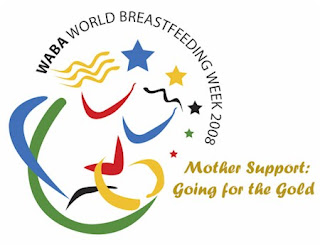

World Breastfeeding Week is celebrated every year from 1 to 7 August in more than 120 countries to encourage breastfeeding and improve the health of babies around the world. It commemorates the Innocent Declaration made by WHO and UNICEF policy-makers in August 1990 to protect promote and support breastfeeding.
Breastfeeding is the best way to provide newborns with the nutrients they need. WHO recommends exclusive breastfeeding until a baby is six months old and continued breastfeeding with the addition of nutritious complementary foods for up to two years or beyond.
The theme of World Breastfeeding Week 2009 is "Breastfeeding - a vital emergency response. Are you ready?" It highlights the need to protect, promote and support breastfeeding in emergencies for infant and young child survival, health and development.
Children are among the most vulnerable groups during emergencies, and small children are the most vulnerable of all, due to increased risk of death due to diarrhea and pneumonia. During emergencies, unsolicited or uncontrolled donations of breast-milk substitutes may undermine breastfeeding and should be avoided.
As part of emergency preparedness, hospitals and other health care services should have trained health workers who can help mothers establish breastfeeding and/or overcome difficulties.
Objectives of World Breastfeeding Week:-
(1) To draw attention to the vital role that breastfeeding plays in emergencies worldwide.
(2) To stress the need for active protection and support of breastfeeding before and during emergencies.
(3) To inform mothers, breastfeeding advocates, communities, health professionals, governments, aid agencies, donors, and the media on how they can actively support breastfeeding before and during an emergency.
(4) To mobilize action and nurture networking and collaboration between those with breastfeeding skills and those involved in emergency response.
Rationale:-
(1) Children are the most vulnerable in emergencies – child mortality can soar from 2 to 70 times higher than average due to diarrhea, respiratory illness and malnutrition.
(2) Breastfeeding is a life saving intervention and protection is greatest for the youngest infants. Even in non-emergency settings, non-breastfed babies under 2 months of age are six times more likely to die.
(3) Emergencies can happen anywhere in the world. Emergencies destroy what is ‘normal,’ leaving caregivers struggling to cope and infants vulnerable to disease and death.
(4) During emergencies, mothers need active support to continue or re-establish breastfeeding.
(5) Emergency preparedness is vital. Supporting breastfeeding in non-emergency settings will strengthen mothers’ capacity to cope in an emergency.
Common misconceptions affecting breastfeeding in emergencies:-
MYTH: “Malnourished mothers cannot breastfeed.”
FACT: Malnourished mothers can breastfeed. Moderate maternal malnutrition has little or no effect on milk production. In fact, the mother will continue to produce milk, at the expense of her own body stores. Extra food and fluids are needed to replenish the mother’s own reserves, and micronutrient supplementation may be needed. She also needs encouragement and support to breastfeed frequently.
SOLUTION: Feed, nurture and support the mother and let her feed the baby.
MYTH: “Stress prevents mothers from producing milk.”
FACT: Stress does not prevent production of milk, but may temporarily interfere with its flow. Breastfeeding mothers have lower stress hormone levels than non-breastfeeding mothers.
SOLUTION: Create conditions for mothers that lessen stress as far as possible – a protected area, a mother-baby tent, reassurance from other women, keeping mothers and babies together, listening to mothers’ special needs – and making sure the child keeps suckling so that milk flow continues.
MYTH: “Once a mother stops breastfeeding, she can’t restart.”
FACT: A mother can restart breastfeeding (relactate) – there is no time limit. In some contexts, grandmothers have breastfed their grandchildren.
SOLUTION: Offer support for breastfeeding and relactation.
MYTH: “HIV positive mothers should never breastfeed.”
FACT: Exclusive breastfeeding for six months is the safest option, unless total replacement feeding is acceptable, feasible, affordable, sustainable and safe (AFASS) – most unlikely in emergencies. After 6 months, if replacement feeding is still not AFASS, then continued breastfeeding with adequate complementary foods is the safest option12. The risk of postnatal transmission can be lowered with mother and/or infant receiving anti-retroviral (ARV) drugs. Mixed feeding in the first six months (combining breastfeeding and formula feeding and/or too-early introduction of complementary foods) is the most risky feeding option, such as diarrhea.






0 komentar:
Posting Komentar